Done for 2009: The Holiday MacBook Pro Roundup
by Anand Lal Shimpi on November 10, 2009 12:00 AM EST- Posted in
- Mac
Performance
Benchmarking under OS X is a bit of a pain. There aren't many good standardized real world benchmarks, and unfortunately the synthetic tests are often over used.
General OS usage is a difficult thing to quantify, but one measure of performance has always been the number of bounces an icon in the dock makes before an application loads. I decided to take it to the next level and write a quick script to launch 15 applications in a row, timing how long the entire process takes.
I launched, in order: Mail, Safari, Activity Monitor, iTunes, iCal, DVD Player, iPhoto, Photo Booth, Quicktime Player, Disk Utility, Preview, iMovie, Front Row, Garage Band and Aperture.
The entire process stresses both the disk and CPU, which is why we see a huge improvement when going to an SSD as well as differences between CPU speeds.
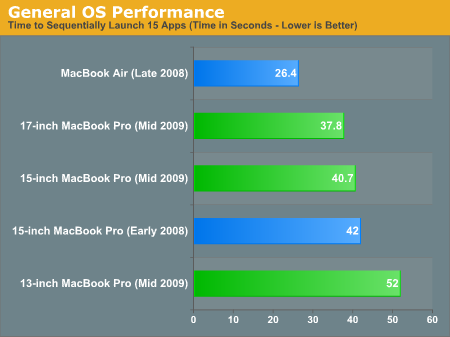
The 13-inch MacBook Pro performs the worst here by a large margin, not just because of its lowly 2.26GHz Core 2 Duo, but also because it only has 2GB of memory. The 13-inch system takes nearly 30% longer to load all of the apps because of its limited amount of memory.
The 15-inch MacBook Pro uses a 2.53GHz Core 2 Duo instead of the 2.80GHz chip in the 17-inch by default. The result is a 7% longer load time on the 15-inch system, not huge, but not insignificant. As always, I recommend getting the fastest CPU you can afford if you're planning on keeping this machine for a while.
The fastest machine here is actually the MacBook Air, because it comes with an SSD. Your best bet to improve overall system responsiveness and launch times is to get a good SSD. Even with only 2GB of memory, the current gen MacBook Air finishes the script faster than the 17-inch MacBook Pro. Paired with an Intel X25-M G2 the 15-inch MacBook Pro can run through our script in 16 seconds.
Adobe Photoshop CS4 Performance
The Retouch Artists Speed Test we use for our CPU testing under Windows also works under OS X. We're running the exact same benchmark here, basically performing a bunch of image manipulations and filters and timing the entire process.
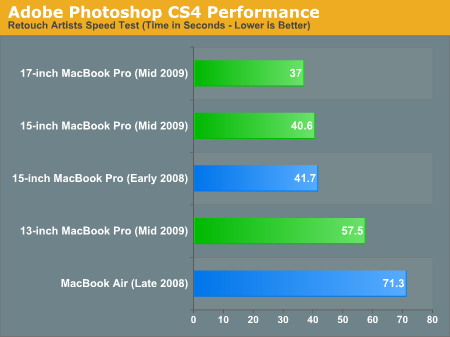
Despite limiting Photoshop to not keeping any history, the 2GB 13-inch MacBook Pro takes around 40% longer to complete the test than the 15-inch MacBook Pro. If you're planning on doing any Photoshop work you'll want to upgrade the 13-inch system to 4GB of memory.
The slower CPU in the 15-inch system penalizes it by around 10% compared to the 17-inch MacBook Pro. For any sort of real performance work, it looks like a 15-inch MacBook Pro with the 2.80GHz upgrade would be a good balance of price/performance.
As I alluded to earlier, there's not much of a performance improvement from the early 2008 MacBook Pro to the current generation. Drive speeds have improved a bit but overall performance hasn't really gone up, it's why Apple had to rely on updated looks and much better battery life to sell systems this time around. Not a bad tradeoff if you ask me, you'll see the performance improvement next year with Arrandale.
Aperture 2 RAW Import
For my Aperture test I simply timed how long it took to import 203 12MP RAW images into the library.
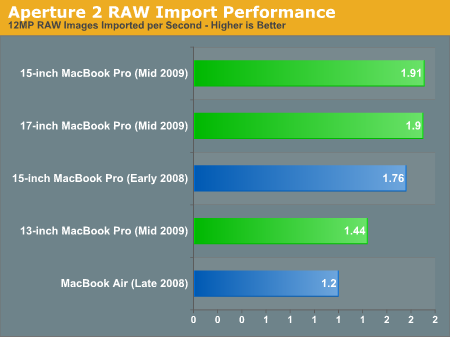
Once again, 2GB isn't enough, the 15-inch and 17-inch are indistinguishable but the 13-inch system takes much longer here.
Cinebench R10
3D rendering performance is mostly CPU bound so the 13-inch system isn't penalized by its memory limitations. Here the 2.53GHz Core 2 Duo is around 11% faster than the 2.26GHz in the 13-inch MBP. The 2.80GHz CPU is another 11% faster on top of that.
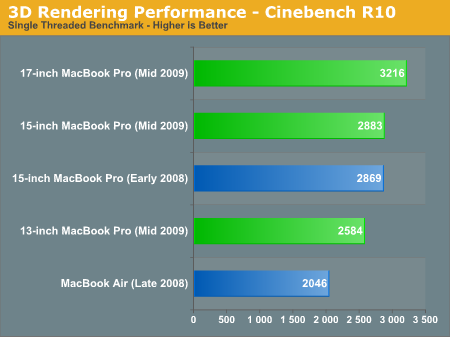
In the multithreaded bench the performance advantages are about the same, a bit closer to 12% between chips.
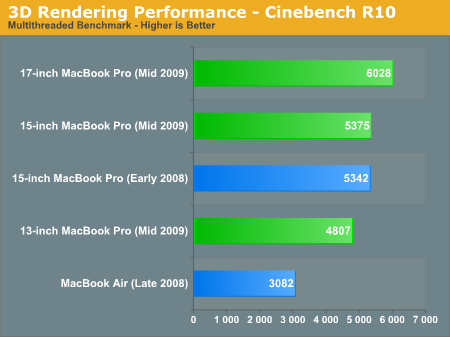
Again we see that CPU speed hasn't really improved much since early 2008, the two 15-inch systems are basically equal performers here.
Quicktime H.264 Video Encoding
Our final benchmark is more consumer focused. Here I'm taking an XviD and converting it to an iPhone-supported H.264 format.
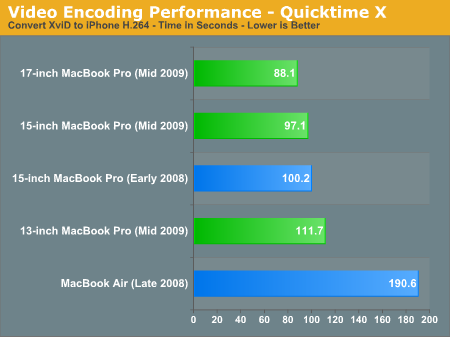
We're CPU bound here so the 13-inch system only takes 14% longer to convert our video clip than the 15-inch. The difference between the 15-inch and 17-inch is about another 10%.










115 Comments
View All Comments
Baron Fel - Wednesday, November 11, 2009 - link
Why didnt you mention the 15" HP Envy? It beats the MBP in everything but battery life...solipsism - Wednesday, November 11, 2009 - link
There is a distinct difference in these machines. For starters, these MBPS have been out many months and won’t be getting an update until after the holidays. If your focus is solely on a Clarksdale quad-core processor.Note that it doesn’t beat the nearly half-a-year old 15” MBP in a lot of areas. It’s nearly 10% thicker, only has a 6-cell battery, while not having an optical drive. I hope that the MBPs come without an optical drive in favour of the OS being installed on a SD Card, but Apple isn’t HP with dozens of machines with the same display size. Apple still runs like a boutique shop so when they commit to removing the optical drive to run a Core i7 quad-core it’ll be for all their 15” notebooks.
far327 - Wednesday, November 11, 2009 - link
Apple equals proprietary gayness!! Design is great. Quality is stellar, but Apple is GAY!!!aapocketz - Thursday, November 12, 2009 - link
I like apples line of laptops, they seem quite well built, though I don't really see a huge benefit of unibody design, I think my ancient ibm laptop is just as nice. I don't really love the glossy screens either. Overall they are nice.apple has some impressive engineering and decent innovation capabilities but their closed and protected platform and general company philosophy is disturbing to someone who relies on and enjoys the openness of hardware and software platforms.
Consider apple disabling support for Atom cpus in the newest OS updates, ostensibly to prevent homebrewers from using the OS on their own hardware like netbooks. Man I certainly don't love Microsoft, but we would be way worse off if Apple dominated the market. I am fine with them as long as they only want that single bite of the apple though.
I like choice and flexibility, and apple computers tightly integrated platform may be a good choice, as long as its not my only choice.
robco - Thursday, November 12, 2009 - link
You have to see on in person to understand why the unibody design has benefits. While still being less than an inch thin, the MacBooks are incredibly rigid. Little flex at all. They feel rock solid. I do agree that the ThinkPads are nice and solid too. If I hadn't gotten a MBP, a ThinkPad was my second choice. You can now custom order the 15 and 17" models with a matte display.I find OS X to be a nice compromise. I like Linux, but it's not always easy to find good software. A lot of FOSS runs under OS X. There's also virtualization to run Linux alongside OS X. A friend who does web development loves the fact that he can run Office, Eclipse, Apache, Tomcat and MySQL all on the same machine easily.
As for dominating the market, I don't think that's Apple's goal - unlike Microsoft. Apple seems pretty happy with their market segment overall. They're raking in a lot of money.
I like my Mac and it's a solid machine. That being said, I'm hardly a fanboy. There are certain circumstances where people should get a Windows machine. As far as Atom support, Apple never supported Atom in the first place, I don't see why they should be expected to provide it or continue providing it. AFAIK, OS X uses some of the optimizations in the Core and Core 2 Duo chips that aren't present in the Atom.
setzer - Wednesday, November 11, 2009 - link
Okay, this is just a supposition because I don't have an actual macbook to test, but I would bet the reason OSx provides so much better battery values is because Apple is running the cpus at a much lower voltage than the defaults, ie, what is here: http://www.thinkwiki.org/wiki/Pentium_M_undervolti...">http://www.thinkwiki.org/wiki/Pentium_M_undervolti...this does make a difference in battery longevity and by default windows doesn't undervolt processors.
blufire - Wednesday, November 11, 2009 - link
I believe it may have more to do with napping and shutting down components more frequently/aggressively..araczynski - Wednesday, November 11, 2009 - link
the macs are starting to smell like pc's now, incompatibilities all over the place.damianrobertjones - Wednesday, November 11, 2009 - link
...so you'd think that with less hardware to code for, that they'd get it right!tuskers - Wednesday, November 11, 2009 - link
At the Mac coverage at this time and place. As a long-time reader of Anandtech, this feels completely out of place from "coverage" and more non-topical than anything I've ever read here, before. We've seen the Macbook Pro reviews already.My guess is that this has to do with one (or more) of three things:
- Anand has turned into the "Mac person" who needs to justify his fanboi-ism.
- There's too little tech news in the holiday season, so this is a classic "fluff" piece, that was easy to write.
- Apple paid the site to publish said fluff piece.
Regardless, journalistically, this is one of the worst pieces I've seen here.
- Failure to analyze the market from a "competitors to Apple" sense. Dell and HP's "representatives" aren't competing with Apple with their mainstream products; instead, they're competing against each other. They're competing on low price to justify expenses with corporations. Most corporations don't care if a laptop is slightly thicker. Instead, pick laptops that are trying to out-Apple Apple, like the Envy or Adamo; Asus and MSI also offer intriguing competition and increasing market shares. Rather than looking at it as "Apple is a mainstream computer maker with 15% of the market", realize that the more true statement is "Apple is dominant in a high-priced niche market which doesn't focus on computing power, here is how it compares to other products competing for that market."
- Exaggeration of differences. The highlighted weight of the 15" MBP is within rounding error of the compared model! And in marketing specs instead of actual product weights, no less.
- Focusing on the battery so much without mentioning that other laptop brands only have to pack a replacement battery to achieve longer battery life. Yes, maintenance is a little more difficult, but you aren't making an honest comparison given that the unibody Macs discarded this functionality.
- A token "please get SSDs to work properly!" plea, without research. Does the "Mac Edition" OCZ Vertex work or not? It's true that OCZ has admitted it as marketing hype, but the least you could do is expose it. You even go so far as to say that some people might be happy to know that random combinations might work-- because people have SSDs lying around.
- I'm amazed a commenter put together the "Flash is 32-bit, so of course it runs slowly talking to 64-bit Safari" before Anand did.
- Blanket statements without truth to them. For instance, the claim that 1920x1200 screen in the 17" is not "bigger than anything else on the market". You simply need to select an Alienware model at Dell's site (a competitive price range for the MBP 17", no less). And then, Anand complains that the pixels are too dense-- a common complaint, which is why Dell offers more 1080p screens instead. I own an Inspiron with a 1920x1200 screen that I bought several years ago. They aren't an Apple monopoly because Apple's the only one that can do it. This whole scenario is worse than simple marketing hype.
I'll leave it there, I'm sure I could find more though. I expect better from this site, Anand!